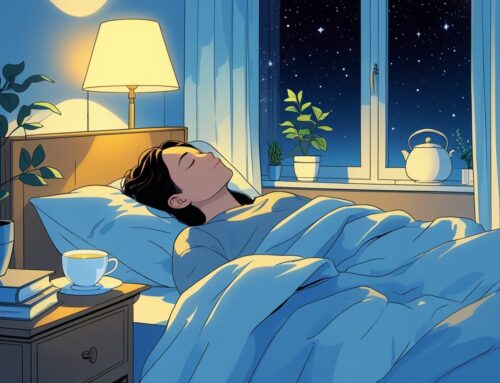Some people feel better sleeping on the floor, but it doesn’t work for everyone. A hard surface can help with posture and keep the spine in line, which may ease certain types of back pain. But it really depends on the person, how they sleep, and if they have other health issues.
For some, the change brings relief. For others, it makes things worse because there’s no cushion. It’s important to think about your own body first. If you have joint problems or trouble moving, the floor might not be a good choice. Weighing the pros and cons can help you figure out if it’s right for you.
If you do try it, it’s best to do it safely so you don’t end up in more pain. In some places, like Japan, people have long used thin mats that are firm but not completely hard. This shows that comfort and support can go together. In the end, the question is simple: does the floor help your back more than a mattress?
Key Takeaways
- Firm surface sleeping can potentially improve spinal alignment.
- Back relief and comfort from floor sleeping is different for different people.
- Proper care and positioning are necessary for safe floor sleeping.
- Mattress with cushioning and specific support protects spinal alignment, whereas floor sleeping has firmer support that can suit some individuals but places joint pressure on others.
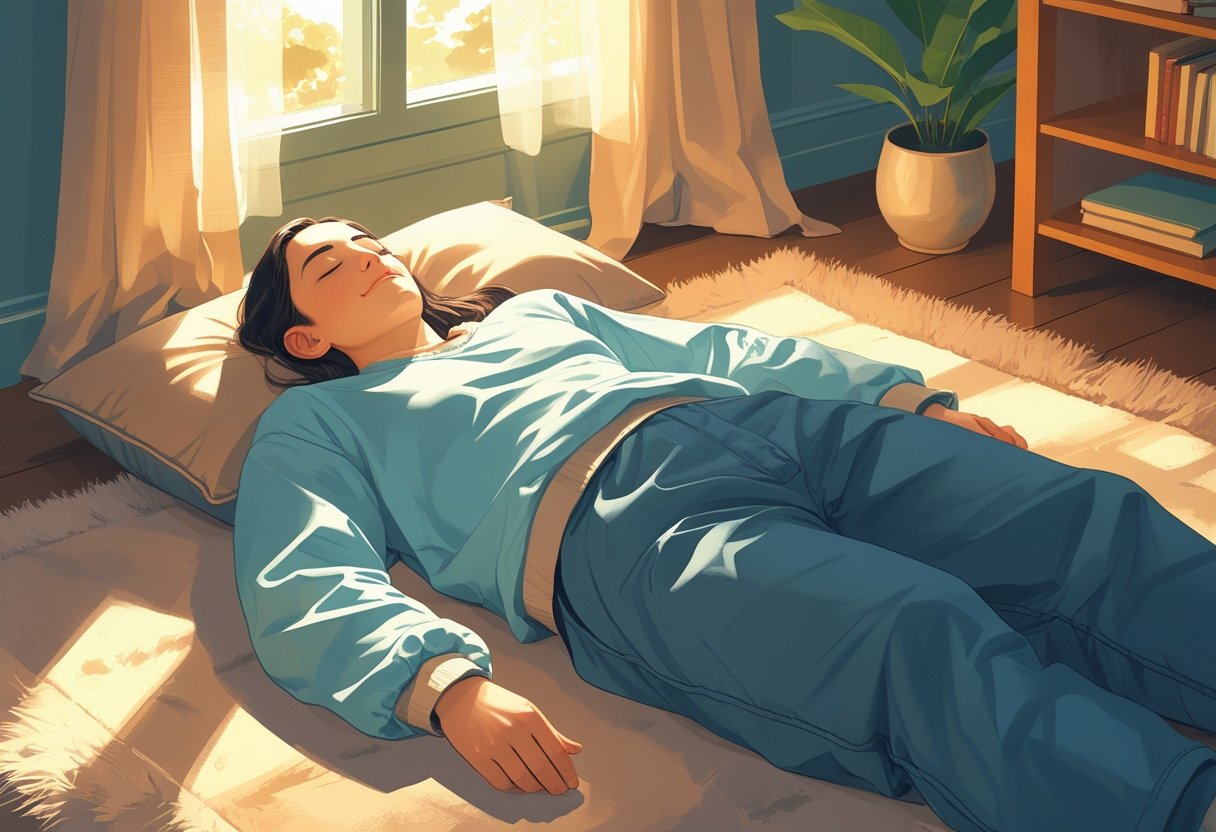
How Sleeping on the Floor Impacts Back Health
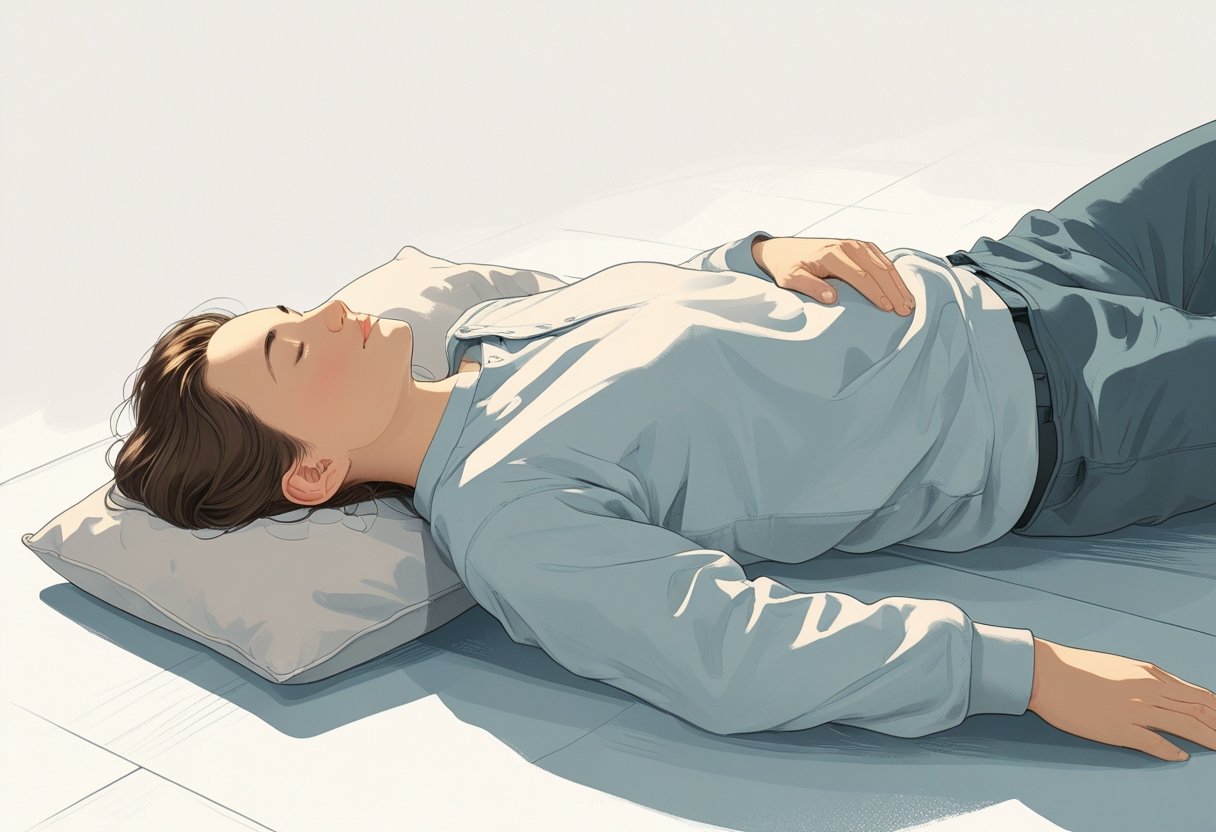
Sleeping on the floor can alter how the body aligns itself when at rest. It impacts pressure points, spine alignment, and muscle tension. This impact can either alleviate or exacerbate back issues based on personal needs and sleeping behaviors.
Possible Relief of Back Pain
Some people say that sleeping on the floor feels better for their back than lying on a soft mattress. A firm, flat surface keeps the body from sinking unevenly, which can help the spine stay straight. This may ease back pain for some, and the harder surface can also stop the spine from curving too much while letting the muscles relax.
But it doesn’t work for everyone. If you’re used to soft beds, the floor can feel too hard at first. Adding a thin layer, like a futon or mat, can make it more comfortable without losing the support.
Spinal Alignment and Posture
An ultra-firm floor can promote improved posture during sleeping by preventing sagging or settling of the body. This helps to preserve spinal alignment, particularly when sleeping on the back.
Important tips for spinal alignment on the floor:
- Sleep on the back with a small pillow under your knees to alleviate lower back strain.
- Side sleepers need to put a pillow between the knees to align hips.
When the spine remains more aligned, pressure points may be diminished and assist the stabilizing muscles of the body. This can enhance posture in the long run.
When Floor Sleeping May Aggravate Back Problems
Sleeping on the floor isn’t comfortable for everyone. For people with joint pain, certain health conditions, or those who are used to soft mattresses, it can actually make the pain worse. Hard floors don’t offer much cushioning, so the pressure ends up on the hips, shoulders, and knees. Side sleepers usually struggle the most because there’s nothing soft to support them.
It can also be tough for older adults or anyone with limited mobility, since getting up from the floor isn’t always easy. Cold floors can make muscles stiff and may even trigger back pain. If you want to try sleeping on the floor, it’s better to ease into it slowly. And before making it a habit, it’s smart to check with your doctor to be sure it’s safe for you.
Benefits of Sleeping on the Floor
Floor sleeping provides certain benefits that are useful to some individuals for health and comfort. They involve spine support, a cooler environment for sleep, and improved muscle relaxation. All of these benefits rely on the individual’s response to floor sleep and his or her need.
Improved Posture
Sleeping on the floor can sometimes help with posture. A firm, flat surface keeps the spine straighter while you rest. Soft mattresses let the body sink, which can twist the spine in ways that don’t feel natural. Over time, a hard surface may reduce slouching and ease the stiffness that comes from waking up sore on a soft bed.
But this isn’t true for everyone. The benefits depend on how you sleep and whether you already have back problems. People with conditions like scoliosis should check with a doctor before trying it. In most cases, the main reason posture can improve is that the spine gets better support and doesn’t sink unevenly the way it might on a soft mattress.
Cooler Sleep
Sleeping close to the floor can actually feel cooler than sleeping higher up in the room. Heat naturally rises, so the air near the floor tends to be a little colder. During hot weather, this can make sleeping more comfortable and may even help improve rest.
For people who often feel too warm at night, this can be a big help. But if you get cold easily or live in a cooler place, sleeping right on the floor might not be as pleasant. Adding a mat, blanket, or other layers can help balance the temperature while still letting you benefit from the cooler air below.
Increased Muscle Relaxation
Sleeping on a hard, supportive surface can contribute to muscle relaxation. In the absence of a soft mattress that causes muscles to sink in unevenly, muscles can lie flatter and recover more evenly. This advantage could decrease tension, particularly in the shoulders and back, where pressure points usually develop on soft mattresses. Better-supported muscles are able to repair themselves at night.
Others describe less stiffness in the morning after they have adjusted to sleeping on the floor. Sleeping on thin padding or a sleeping mat is possible to improve comfort while retaining firm support that allows muscles to relax.
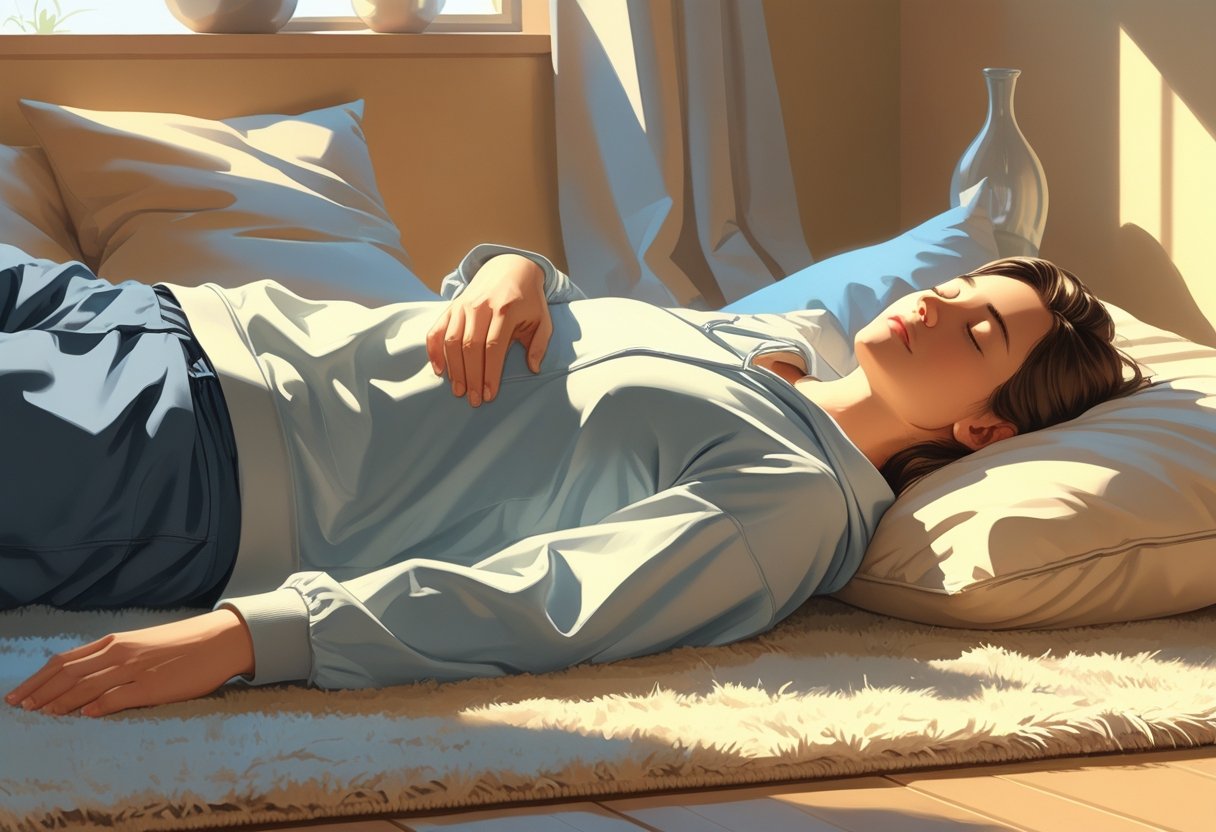
Potential Downsides and Risks
Floor sleeping might not be so comfortable for everyone and may present difficulties. Others would experience stiffness or pain in adapting to the firm surface. In some medical conditions, floor sleeping would be a problem. Allergies and hygiene are also factors to consider.
Discomfort and Initial Adjustment
The hardness of the floor surface can be discomforting, particularly initially. Pressure points on hips, shoulders, and knees can be developed without adequate cushioning. This can be followed by morning stiffness or soreness. Individuals accustomed to soft beds may have difficulty sleeping soundly at first. Lack of support may put strain on joints and muscles until one’s body has adjusted. A thin blanket or mat can serve to cushion this transition.
Poor spinal alignment can also cause discomfort if the floor is not level or pillows are improperly used. In some individuals, this can lead to back pain instead of relief.
Who Should Steer Clear of Floor Sleeping
Not everyone needs to sleep on the floor because it exacerbates some illnesses. Individuals with chronic backache may find the floor to be too firm and thus more painful when they lack adequate support for their spine. Individuals who have arthritis, joint complications, or mobility impairment may find more stiffness or discomfort. Sleeping on the floor will make it hard to move up and down in such cases.
Pregnant women are normally discouraged from sleeping on the floor. It may decrease circulation and add pressure to veins, which might be harmful to mother and child. Adults of advanced age or individuals with medical issues that compromise circulation or balance should exercise care before opting for floor sleeping as a routine.
Allergies and Cleanliness Issues
Sleeping on the floor might seem simple, but it comes with a few risks. Floors collect dust, pet hair, and even mold. These can trigger allergies or breathing problems, especially for people who are sensitive. Insects can also be an issue since you’re closer to the ground. Keeping the floor clean helps, but it’s not always easy. If you want to sleep on the floor, using a clean mat or hypoallergenic bedding can lower the risk. Still, anyone with asthma or sensitive airways may notice their symptoms get worse.
Skin can also get irritated if you’re lying on the floor every night. Washing regularly and making sure your bedding is clean is important to avoid rashes or infections.
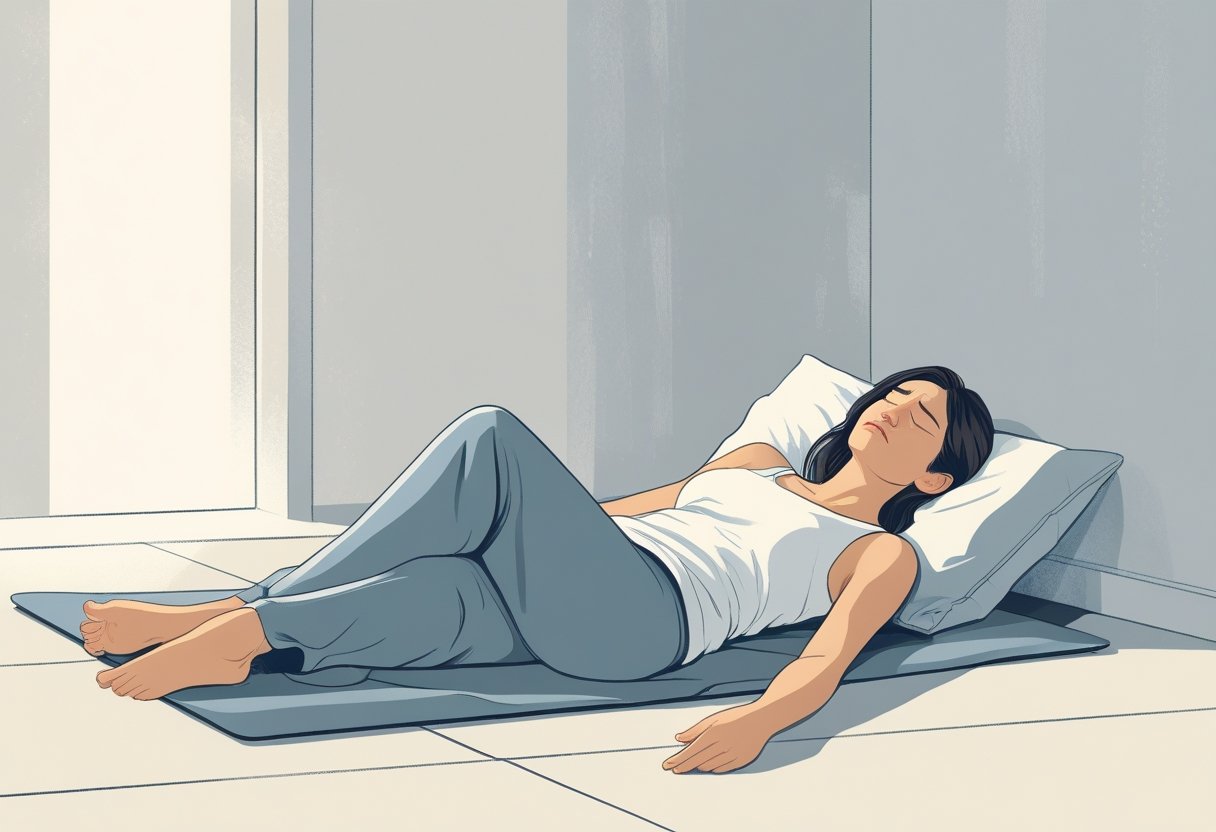
Best Practices for Safe and Comfortable Floor Sleeping
Floor sleeping involves careful modifications to prevent discomfort or injury. Tips include selecting the appropriate sleeping position, incorporating supportive bedding such as mats and pillows, and acclimating the body to this alteration slowly. These measures minimize pressure on joints and provide spinal alignment support.
Best Sleeping Positions
The back sleep position is optimal for normal sleeping on a floor. It keeps the spine in its natural form by distributing weight evenly, which reduces back pain. A pillow under the knees also helps support the lower back by unloading pressure.
It is possible to sleep on the side but requires special attention. Pillows can be put between the knees to maintain hip alignment and under the head for supporting the neck. This arrangement supports the prevention of strain on the spine and joints.
Stomach sleeping is not usually advisable on a hard floor. It tends to put extra stress on the neck and lower back, causing pain. If one likes this position, thin bedding underneath can minimize pressure points.
Utilizing Mats, Pillows, or Blankets
Sleeping on the floor can be comfortable if you set it up right. A firm mattress, a futon, or even a thin mat is usually enough to soften the surface without losing the support the floor gives. This way, you avoid the aches that come from lying directly on hard flooring.
The pillow you use also makes a big difference. A good one keeps your head and neck in line with your spine. Some people also place a rolled towel or extra pillow under their knees or hips to ease pressure and make it easier to relax.
Blankets help in more ways than just warmth. They add a bit of cushion and act as a barrier from the cold or rough floor. If you fold them up or layer them, you can adjust the softness to match what feels best for you.
Gradual Transition from Mattress to Floor
Gradual transition avoids shock to the body. Beginning with brief naps on the floor can allow the body to adjust to the harder surface without inducing pain. Adjustments must be made according to comfort. In case any pain or stiffness develops, adjustments in sleep position or bedding are required. Listening to one’s body is important in the process.
Consistency is essential. The body, in a few days or weeks, might get accustomed to sleeping on the floor, which can enhance posture and back comfort. One must advise a specialist, though, before attempting to switch.
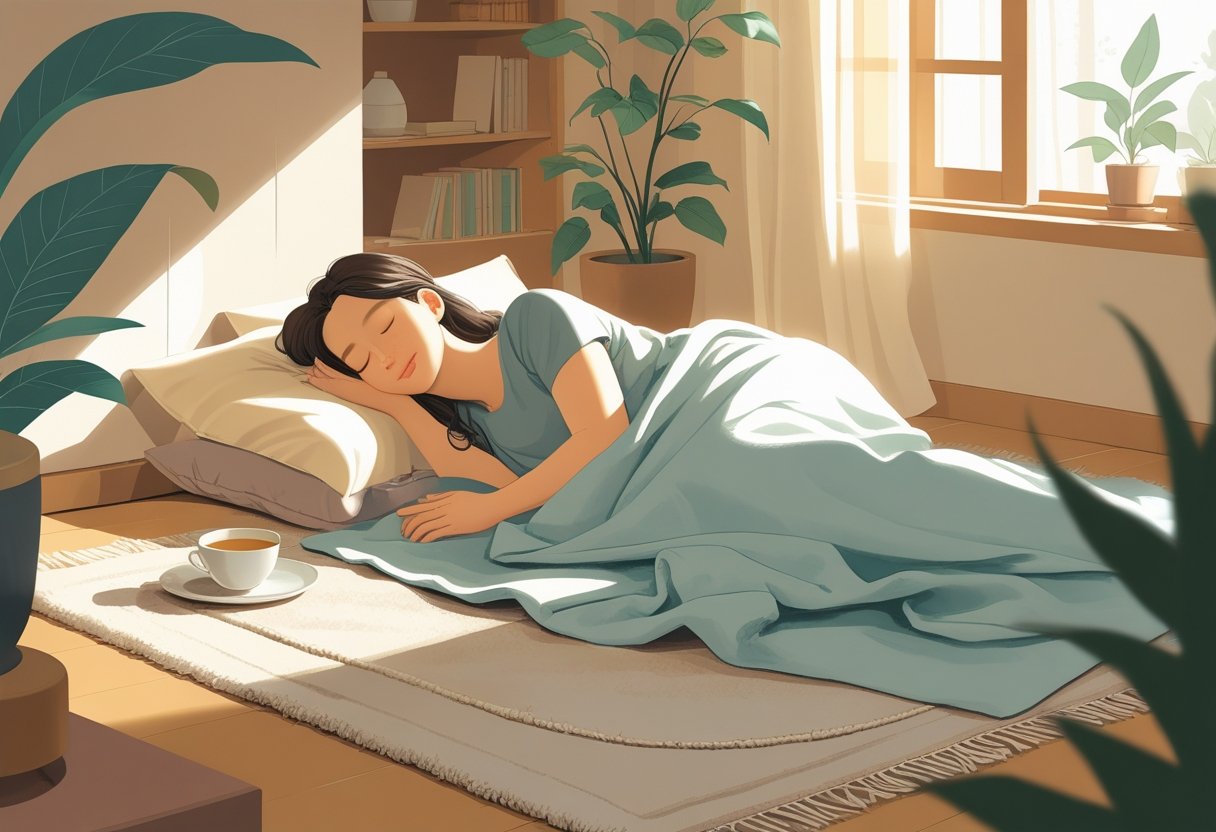
Cultural Practices and Alternative Approaches
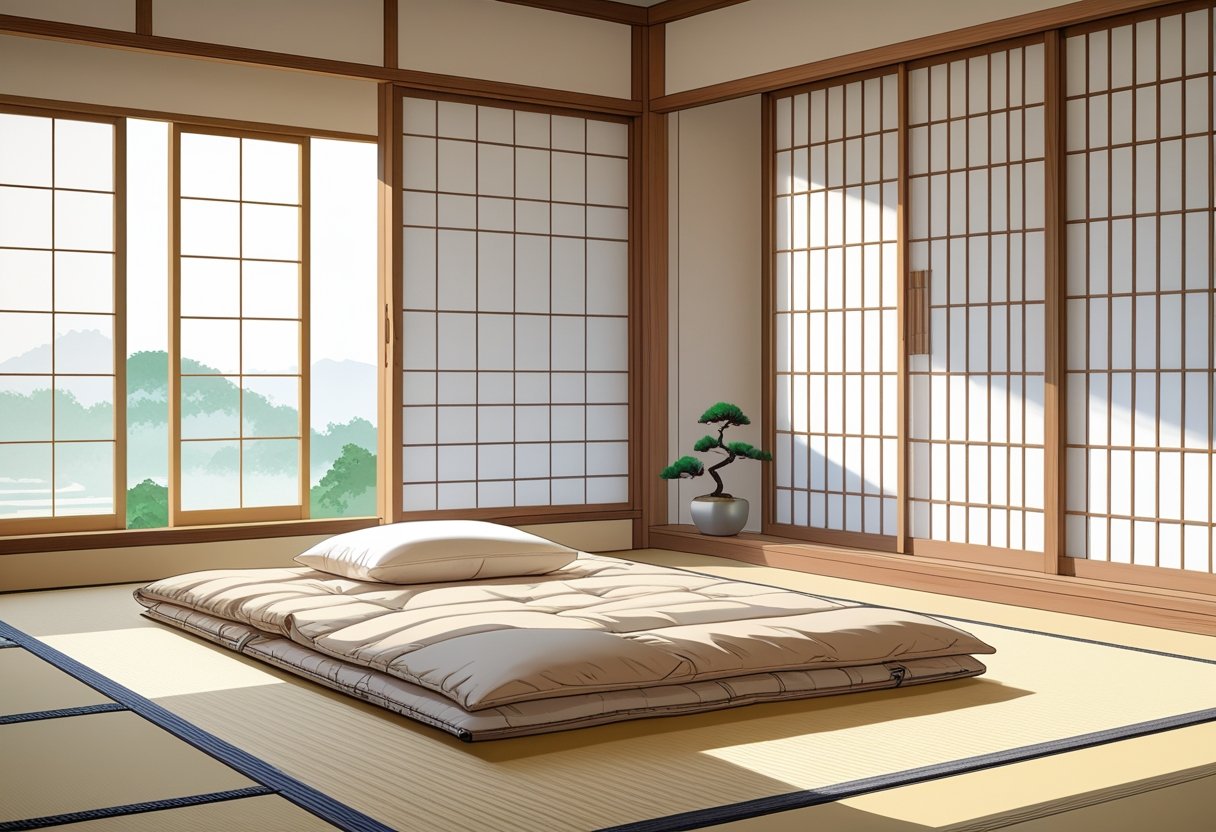
Floor sleeping is practiced in most cultures and is adopted for various purposes, such as health advantages, cost-effectiveness, and lifestyle. Sleeping on the floor may have common experiences of people regarding improved posture or comfort compared to sleeping on raised beds.
Japanese Futon Sleeping
Traditionally in Japan, futon sleeping takes the form of thin mattresses being laid on tatami mats on the floor. The combination of firmness with minimal cushioning provides natural spinal support. The futon is rolled up and kept in place during the day, which provides savings in space and prevents the sleeping area from getting dirty.
The hardness of the futon and tatami mat will assist in alleviating back pain for others by promoting a neutral sleeping position. Yet this technique is not suitable for all, particularly individuals who have joint problems. Tatami mats with the breathable natural components also assist in controlling heat and moisture, which makes sleeping on the floor suitable for various seasons.
Minimalist and Lifestyle Choices
Others prefer floor sleeping as an alternative to mainstream living. They tend to enjoy sleeping on the floor because it decreases clutter and appeals to simplicity values. Floor sleeping is common among tiny house dwellers and individuals who want to minimize dependence on big bed frames and heavy mattresses.
Some people use thin mattresses or even mats on the floor to merge comfort and the hardness of the floor. This may give the advantage of back support without the sinkiness that some mattresses have. Some people find that sleeping in this manner helps their quality of sleep and comfort in their backs, although there is little scientific research supporting this.
Personal Preferences and Experiences
Individual reasons for enjoying floor sleeping are diverse. Some claim that they sleep more comfortably on the floor since it is cooler or since firmness eliminates pressure from their back. Others prefer sleeping on the mattress on the floor as it helps ease their back pain by avoiding poor posture due to soft beds.
Sleeping on the floor is normally acceptable if someone doesn’t have specific medical issues such as joint pain or circulatory problems. Gradually making the change by laying down a mattress or thick mat on the floor can facilitate adaptation. Allergen control and cleanliness help to prevent discomfort or health problems in sleeping near the ground.
Comparing Floor Sleeping to Mattress Use
Slumbering on the floor may provide more firm support, which some claim enhances spinal alignment. In contrast, mattresses have differing firmness levels and can support or stress the back based on quality. Appreciating how each method impacts encourages the selection of appropriate needs for one’s individual back health.
Medium-Firm Mattress vs. Floor
A medium-firm mattress tends to find a balance between comfort and support, ensuring the spine stays in a neutral position. Such a mattress can absorb pressure points without excessive sinking, which is suitable for most individuals with back pain.
By comparison, sleeping on the floor directly offers a very hard surface that can minimize over-sinking but is uncomfortable without a cushion. Floor sleeping is reported by some to alleviate back pain by encouraging improved posture, yet others find more stiffness from the hard surface.
Both alternatives must be able to adjust the sleeper’s sleeping position and body shape. The use of pillows or thin mats on the ground can enhance comfort and avoid applying pressure to the joints.
Back Health Issues with Mattresses
A mattress that’s too soft can make your body sink in ways that strain your back. On the other hand, one that’s too firm, or even sleeping straight on the floor, can create pressure points and leave you sore.
Good support for the lower back is important. A mattress with zoned support or even a thin sleeping mat can help keep your spine in line. But lying on the floor without any padding or airflow can trap moisture, which may cause mold if you do it for long periods.
The right level of firmness depends on you, your weight, your comfort, and whether you already have back problems. If pain is an issue, it’s best to talk to a doctor to figure out what type of mattress or surface will keep your back healthy.
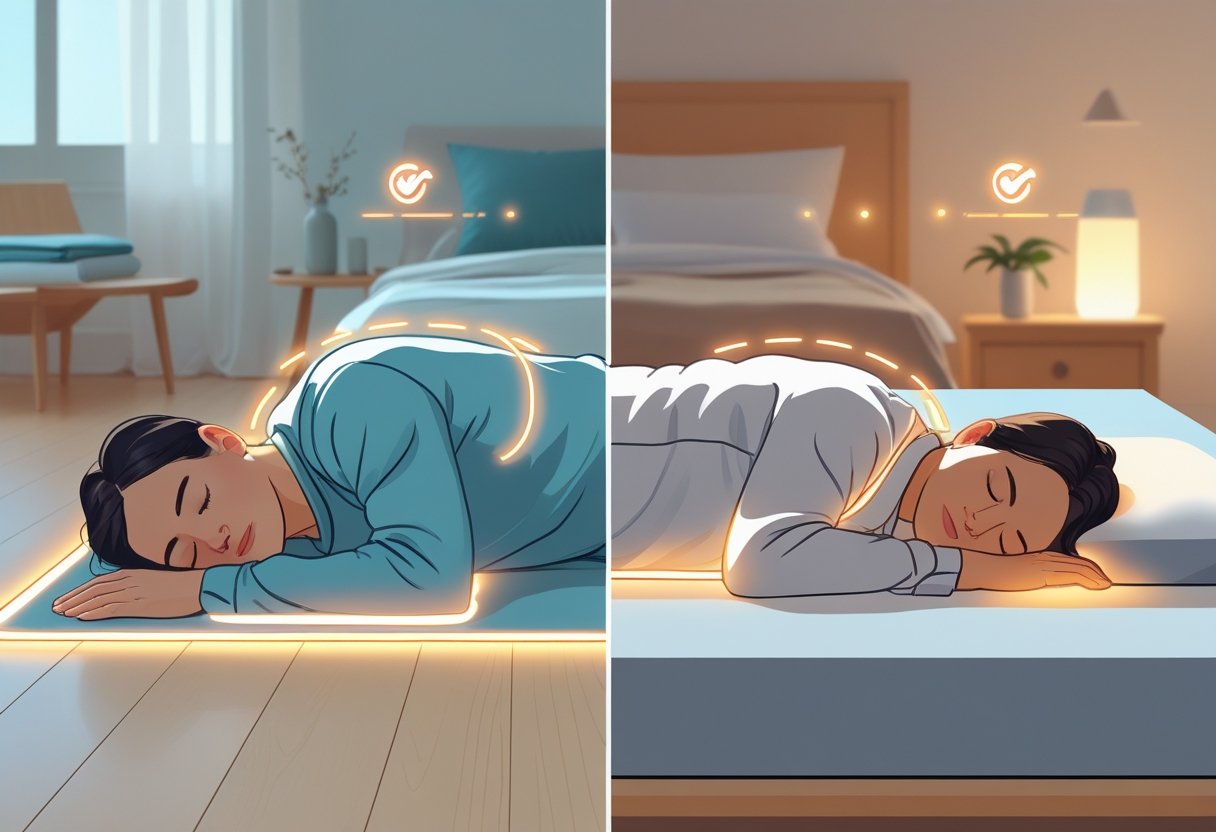
How a Mattress Compares to Floor Sleeping for Back Support
A bed provides a cushioned surface that adjusts to the body, dissipating pressure points and providing more even spine support than a hard floor.
On the other hand, sleeping on the floor provides harder support, which can do a better job of keeping a neutral spine position for some people. Still, it might put extra pressure on joints and be uncomfortable if the surface is too hard or bumpy.
Key differences:
- Mattress: Smoother, conforms to body, eases pressure relief
- Floor: More firm, less contouring, can enhance the alignment of the spine in certain situations
The right mattress firmness is important. A too-soft mattress can allow the body to sink and thereby compromise spinal alignment, and a too-firm mattress can strain muscles and joints. Floor sleeping approximates a very firm surface, which is helpful to some but not to everyone.
Utilization of pillows or cushions on the ground can add comfort and support, keep sleeping posture improved, and decrease the risk of pain.
Consider personal comfort and symptoms of back pain. What is comfortable for one may not be the same for another. For one who is looking for a mattress that has pressure relief, spinal support, and cooling, the Helix Midnight Luxe provides a medium plush sensation with zoned lumbar support and an option of breathable Tencel or GlacioTex Cooling Covers.
The Helix Midnight Luxe is particularly notable with its six-layer hybrid design, comprising individually wrapped coils and memory foam to offer focused support and pressure relief. Its pillow top quilted in premium adds the extra measure of comfort, making it particularly suitable for side sleepers and those with back pain. The advanced cooling technology in the mattress guarantees a comfortable sleeping environment, combating overheating problems associated with most mattresses.

Frequently Asked Questions
Sleeping on the floor impacts back health in varying ways. It can take pressure off some individuals, while others feel it is uncomfortable. Some back issues can get better on hard surfaces, but there are risks involved based on the requirements and conditions of a given person.

